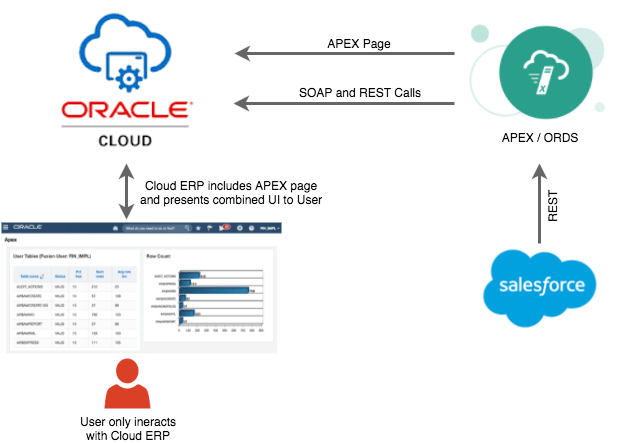Introduction
Also consider how the APEX product has evolved to add a fantastic UI to it's existing data processing pedigree. There is no more powerful a data processing engine than the Oracle database. Couple that with a now aesthetically pleasing and functional UI and you have the complete web development package. Add to that, sophisticated web service hosting and consumption capabilities and the possibilities are seemingly endless.
All of this makes APEX is a natural choice for extending Oracle's Cloud ERP. A topic which I will expand on in this post. I will discuss four use cases where APEX and Cloud ERP could meet and dive into a use case for each.
Cloud ERP/APEX UI Mashup
The example use case involves an APEX page being embedded in a tab within Cloud ERP. The embedded page allows a Cloud ERP user to search prospects (in real-time) from Salesforce, identify a specific prospect and click a button to convert the prospect to a Cloud ERP customer.
Behind the Scenes
When the user opens the APEX page in ERP Cloud, a Java Web Token (JWT) is generated by Cloud ERP and passed to APEX. APEX verifies the JWT, authenticates the user and returns a search page to be rendered in the Cloud ERP window. Once the user enters their search criteria, APEX calls a Salesforce REST service to fetch prospect data and displays it in a table on the embedded APEX page. When the users identifies a prospect and clicks convert, APEX calls a web service in Cloud ERP to create the customer and tag it with the ID of the Salesforce prospect. APEX will then call a REST service in Salesforce to mark the prospect as converted and update field with Cloud ERP Customer number.
Standalone Cloud ERP Connected Apps
In the use case example, an APEX dashboard is built which pulls financial summaries from Cloud ERP via calls to the BI Publisher web service. This data is incorporated (in real time) with data from an on premise treasury system and financial data from a subsidiary which is running SAP. APEX provides sophisticated charting capabilities to provide visualizations for the data to facilitate decision making.
Behind the Scenes
Users would authenticate into the APEX application using their Cloud ERP credentials. The challenge here is that there is currently no user authentication service available in Cloud ERP. You can work around this by making a call to any web service using the users Cloud ERP credentials. The response will determine if the username and password are correct and allow them into your APEX application. Once in the application, you would utilize the users credentials (for the duration of the session only) to call SOAP and REST based services in Cloud ERP to fetch data.
You can build custom BI Publisher (or OTBI) reports to provide pre-summarized data in XML format and call these reports using the BI Publisher web service to pull the data into APEX. That way, Cloud ERP does a lot of the heavy lifting and you are not pulling thousands of records across the network. You will want to consider caching certain data in the local (local to APEX anyway) database. This will significantly reduce latency in making multiple calls to the Cloud ERP web services. Lookups, currency conversions and additional data manipulation can be all performed in the APEX database.
Standalone Mobile APEX Apps
An example use case could be to provide project managers a mobile UI using APEX that allows them to capture images of the worksite and upload them as attachments to a project in Cloud ERP.
I won't go into behind the scenes detail here, as aside from utilizing a mobile UI, the rest of the approach is the same as my previous example.
Integration Platform
At this point, I can almost hear the sharp intakes of breath from the SOA purists. I would say, however, if you are advising your small to mid-size Cloud customer, can you honestly justify thousands of dollars a month for the all in solution when you could be spending as little as $175/month for Exadata Express? I am not advocating GE do it this way but it is fit for purpose for many customers.
Use Case: Employee Synchronization
An example use case is a customer who needs to sync employees between Workday and Cloud ERP. A scheduled database job in your APEX database runs and pulls employees added/changed in the past 5 minutes in WorkDay. I then performs transformations on the data and calls a REST service in ERP Cloud to propagate the change there.
Guess what, because we have APEX in our database, we can build automated email alerts when something goes wrong. We can also build a monitoring UI to keep track of what's going on.



 RSS Feed
RSS Feed